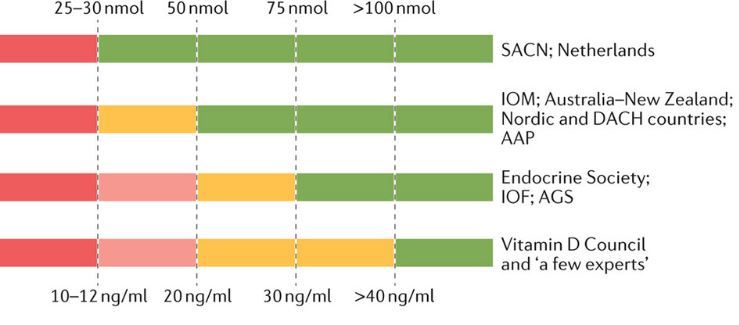Vitamin D consensus: 400 IU for infants, less than 10 ng is too low, if low sun need to supplement
Comparative analysis of nutritional guidelines for vitamin D
Nature Reviews Endocrinology 13, 466–479 (2017) doi:10.1038/nrendo.2017.31 April 2017
Roger Bouillon

Vitamin D is essential for calcium and bone homeostasis. Humans are largely dependent on UVB-radiation-induced photosynthesis of vitamin D, as few foods contain vitamin D. However, the same radiation that produces vitamin D is also carcinogenic, albeit with a long lag time, and causes DNA damage. In view of the increasing life expectancy, avoiding excessive sun exposure is prudent. Several groups of people have a shortfall between their requirements for vitamin D and their combined endogenous synthesis and intake from natural foods, and therefore need vitamin D supplementation. Governments and scientific societies are regularly updating their recommendations for intake of vitamin D, especially for groups that should (infants) or prefer to (especially elderly individuals) avoid direct sunlight. An overview of such guidelines is presented in this Review.
A fairly large consensus exists that all infants should receive 400 international units (IU) (10 μg) daily during their first year of life and that elderly individuals should have access to vitamin D supplementation (at recommended dosages varying from 400 IU to 800 IU daily in most governmental guidelines but at higher dosages in other guidelines).
All guidelines unanimously agree that serum levels of 25-hydroxyvitamin D (25OHD) <25 nmol/l (10 ng/ml) should be avoided at all ages.
Children and adults who have limited sun exposure should receive vitamin D supplementation, but the recommended doses vary widely (from 200 IU to 2,000 IU daily), in line with disagreement regarding the minimal desirable serum concentration of 25OHD (which varies from 25 nmol/l to >100 nmol/l).
📄 Download the PDF from sci-hub via Vitamin D Life
See also Vitamin D Life
Seniors need at least 4,000 IU vitamin D, no test needed – Consensus Jan 2014
1000 IU should be the new vitamin D RDA (if you think 20 ng is enough) - May 2017
Vitamin D needs in 2004:1000 IU, 10 years later same author says 3,500 IU
50,000 IU of vitamin D every two weeks – Jordan conclusion - RCT July 2017
Is 50 ng of vitamin D too high, just right, or not enough
Recommendations around the world click on chart for details

Proof that Vitamin D Works 80 health problems prevented and/or treated with Vitamin D intervention as of May 2017
